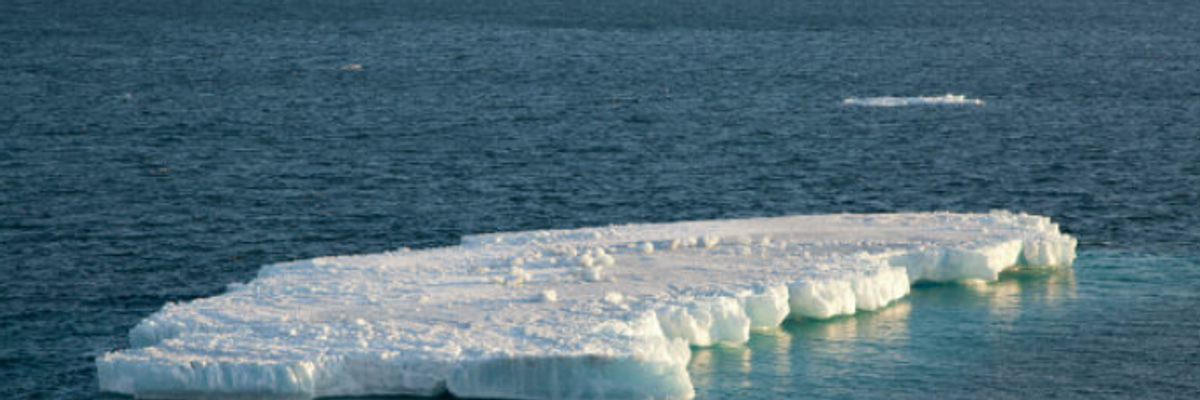
An iceberg floats in the Chukchi Sea in the Arctic Ocean. (Credit: NOAA)
To donate by check, phone, or other method, see our More Ways to Give page.

An iceberg floats in the Chukchi Sea in the Arctic Ocean. (Credit: NOAA)
With the smallest winter sea ice coverage since record-keeping began and the second warmest year ever in the Arctic, a new NOAA-sponsored study out Tuesday reveals the polar region continues to bear the brunt of the world's climate crisis.
"While 2017 saw fewer records shattered than in 2016," NOAA noted in a statement, "the Arctic shows no sign of returning to the reliably frozen region it was decades ago. Arctic temperatures continue to increase at double the rate of the global temperature increase."
Citing historical data, the research found that "the current observed rate of sea ice decline and warming temperatures are higher than at any other time in the last 1,500 years, and likely longer than that."
\u201cThe #Arctic saw its 2nd warmest year on record, says @NOAA's Arctic Report Card issued at #AGU17. This #satellite-based animation shows Arctic sea ice concentration was below average during much of 2017. More info: https://t.co/PmPCRjrUVL\u201d— NOAA Satellites (@NOAA Satellites) 1513104852
This is the twelfth year for the annual report, called the Arctic Report Card, a peer-reviewed collaboration sponsored by the agency that brought together the work of 85 scientists from 12 nations.
During his a presentation of the report on Tuesday at the meeting of the American Geophysical Union, taking place this week in New Orleans, Jeremy Mathis, director of NOAA's Arctic Research Program, explained that the Arctic region is currently "going through the most unprecedented transition in human history, and we need better observations to understand and predict how these changes will affect everyone, not just the people of the north."
Among the other major findings of the report:
Donald Trump’s attacks on democracy, justice, and a free press are escalating — putting everything we stand for at risk. We believe a better world is possible, but we can’t get there without your support. Common Dreams stands apart. We answer only to you — our readers, activists, and changemakers — not to billionaires or corporations. Our independence allows us to cover the vital stories that others won’t, spotlighting movements for peace, equality, and human rights. Right now, our work faces unprecedented challenges. Misinformation is spreading, journalists are under attack, and financial pressures are mounting. As a reader-supported, nonprofit newsroom, your support is crucial to keep this journalism alive. Whatever you can give — $10, $25, or $100 — helps us stay strong and responsive when the world needs us most. Together, we’ll continue to build the independent, courageous journalism our movement relies on. Thank you for being part of this community. |
With the smallest winter sea ice coverage since record-keeping began and the second warmest year ever in the Arctic, a new NOAA-sponsored study out Tuesday reveals the polar region continues to bear the brunt of the world's climate crisis.
"While 2017 saw fewer records shattered than in 2016," NOAA noted in a statement, "the Arctic shows no sign of returning to the reliably frozen region it was decades ago. Arctic temperatures continue to increase at double the rate of the global temperature increase."
Citing historical data, the research found that "the current observed rate of sea ice decline and warming temperatures are higher than at any other time in the last 1,500 years, and likely longer than that."
\u201cThe #Arctic saw its 2nd warmest year on record, says @NOAA's Arctic Report Card issued at #AGU17. This #satellite-based animation shows Arctic sea ice concentration was below average during much of 2017. More info: https://t.co/PmPCRjrUVL\u201d— NOAA Satellites (@NOAA Satellites) 1513104852
This is the twelfth year for the annual report, called the Arctic Report Card, a peer-reviewed collaboration sponsored by the agency that brought together the work of 85 scientists from 12 nations.
During his a presentation of the report on Tuesday at the meeting of the American Geophysical Union, taking place this week in New Orleans, Jeremy Mathis, director of NOAA's Arctic Research Program, explained that the Arctic region is currently "going through the most unprecedented transition in human history, and we need better observations to understand and predict how these changes will affect everyone, not just the people of the north."
Among the other major findings of the report:
With the smallest winter sea ice coverage since record-keeping began and the second warmest year ever in the Arctic, a new NOAA-sponsored study out Tuesday reveals the polar region continues to bear the brunt of the world's climate crisis.
"While 2017 saw fewer records shattered than in 2016," NOAA noted in a statement, "the Arctic shows no sign of returning to the reliably frozen region it was decades ago. Arctic temperatures continue to increase at double the rate of the global temperature increase."
Citing historical data, the research found that "the current observed rate of sea ice decline and warming temperatures are higher than at any other time in the last 1,500 years, and likely longer than that."
\u201cThe #Arctic saw its 2nd warmest year on record, says @NOAA's Arctic Report Card issued at #AGU17. This #satellite-based animation shows Arctic sea ice concentration was below average during much of 2017. More info: https://t.co/PmPCRjrUVL\u201d— NOAA Satellites (@NOAA Satellites) 1513104852
This is the twelfth year for the annual report, called the Arctic Report Card, a peer-reviewed collaboration sponsored by the agency that brought together the work of 85 scientists from 12 nations.
During his a presentation of the report on Tuesday at the meeting of the American Geophysical Union, taking place this week in New Orleans, Jeremy Mathis, director of NOAA's Arctic Research Program, explained that the Arctic region is currently "going through the most unprecedented transition in human history, and we need better observations to understand and predict how these changes will affect everyone, not just the people of the north."
Among the other major findings of the report: